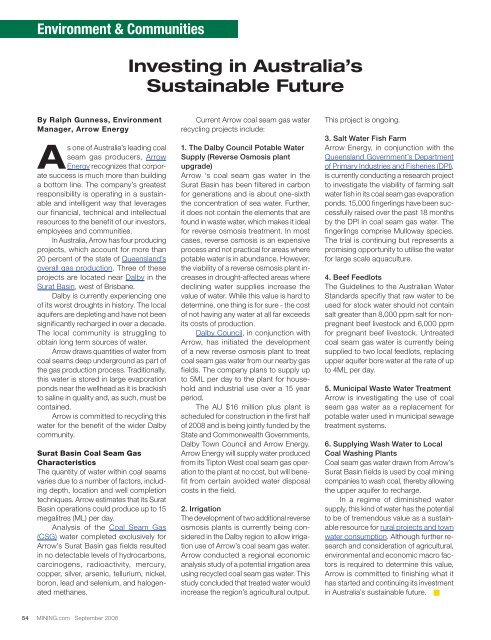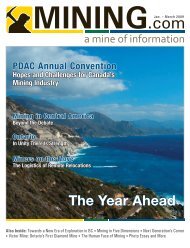You also want an ePaper? Increase the reach of your titles
YUMPU automatically turns print PDFs into web optimized ePapers that Google loves.
Environment & Communities<br />
By Ralph Gunness, Environment<br />
Manager, Arrow Energy<br />
As one of Australia’s leading coal<br />
seam gas producers, Arrow<br />
Energy recognizes that corporate<br />
success is much more than building<br />
a bottom line. The <strong>com</strong>pany’s greatest<br />
responsibility is operating in a sustainable<br />
and intelligent way that leverages<br />
our financial, technical and intellectual<br />
resources to the benefit of our investors,<br />
employees and <strong>com</strong>munities.<br />
In Australia, Arrow has four producing<br />
projects, which account for more than<br />
20 percent of the state of Queensland’s<br />
overall gas production. Three of these<br />
projects are located near Dalby in the<br />
Surat Basin, west of Brisbane.<br />
Dalby is currently experiencing one<br />
of its worst droughts in history. The local<br />
aquifers are depleting and have not been<br />
significantly recharged in over a decade.<br />
The local <strong>com</strong>munity is struggling to<br />
obtain long term sources of water.<br />
Arrow draws quantities of water from<br />
coal seams deep underground as part of<br />
the gas production process. Traditionally,<br />
this water is stored in large evaporation<br />
ponds near the wellhead as it is brackish<br />
to saline in quality and, as such, must be<br />
contained.<br />
Arrow is <strong>com</strong>mitted to recycling this<br />
water for the benefit of the wider Dalby<br />
<strong>com</strong>munity.<br />
Surat Basin Coal Seam Gas<br />
Characteristics<br />
The quantity of water within coal seams<br />
varies due to a number of factors, including<br />
depth, location and well <strong>com</strong>pletion<br />
techniques. Arrow estimates that its Surat<br />
Basin operations could produce up to 15<br />
megalitres (ML) per day.<br />
Analysis of the Coal Seam Gas<br />
(CSG) water <strong>com</strong>pleted exclusively for<br />
Arrow’s Surat Basin gas fields resulted<br />
in no detectable levels of hydrocarbons,<br />
carcinogens, radioactivity, mercury,<br />
copper, silver, arsenic, tellurium, nickel,<br />
boron, lead and selenium, and halogenated<br />
methanes.<br />
54 <strong>MINING</strong>.<strong>com</strong> September 2008<br />
Investing in Australia’s<br />
Sustainable Future<br />
Current Arrow coal seam gas water<br />
recycling projects include:<br />
1. the dalby Council Potable Water<br />
Supply (reverse osmosis plant<br />
upgrade)<br />
Arrow ‘s coal seam gas water in the<br />
Surat Basin has been filtered in carbon<br />
for generations and is about one-sixth<br />
the concentration of sea water. Further,<br />
it does not contain the elements that are<br />
found in waste water, which makes it ideal<br />
for reverse osmosis treatment. In most<br />
cases, reverse osmosis is an expensive<br />
process and not practical for areas where<br />
potable water is in abundance. However,<br />
the viability of a reverse osmosis plant increases<br />
in drought-affected areas where<br />
declining water supplies increase the<br />
value of water. While this value is hard to<br />
determine, one thing is for sure - the cost<br />
of not having any water at all far exceeds<br />
its costs of production.<br />
Dalby Council, in conjunction with<br />
Arrow, has initiated the development<br />
of a new reverse osmosis plant to treat<br />
coal seam gas water from our nearby gas<br />
fields. The <strong>com</strong>pany plans to supply up<br />
to 5ML per day to the plant for household<br />
and industrial use over a 15 year<br />
period.<br />
The AU $16 million plus plant is<br />
scheduled for construction in the first half<br />
of 2008 and is being jointly funded by the<br />
State and Commonwealth Governments,<br />
Dalby Town Council and Arrow Energy.<br />
Arrow Energy will supply water produced<br />
from its Tipton West coal seam gas operation<br />
to the plant at no cost, but will benefit<br />
from certain avoided water disposal<br />
costs in the field.<br />
2. irrigation<br />
The development of two additional reverse<br />
osmosis plants is currently being considered<br />
in the Dalby region to allow irrigation<br />
use of Arrow’s coal seam gas water.<br />
Arrow conducted a regional economic<br />
analysis study of a potential irrigation area<br />
using recycled coal seam gas water. This<br />
study concluded that treated water would<br />
increase the region’s agricultural output.<br />
This project is ongoing.<br />
3. Salt Water fish farm<br />
Arrow Energy, in conjunction with the<br />
Queensland Government’s Department<br />
of Primary Industries and Fisheries (DPI),<br />
is currently conducting a research project<br />
to investigate the viability of farming salt<br />
water fish in its coal seam gas evaporation<br />
ponds. 15,000 fingerlings have been successfully<br />
raised over the past 18 months<br />
by the DPI in coal seam gas water. The<br />
fingerlings <strong>com</strong>prise Mulloway species.<br />
The trial is continuing but represents a<br />
promising opportunity to utilise the water<br />
for large scale aquaculture.<br />
4. Beef feedlots<br />
The Guidelines to the Australian Water<br />
Standards specifiy that raw water to be<br />
used for stock water should not contain<br />
salt greater than 8,000 ppm salt for nonpregnant<br />
beef livestock and 6,000 ppm<br />
for pregnant beef livestock. Untreated<br />
coal seam gas water is currently being<br />
supplied to two local feedlots, replacing<br />
upper aquifer bore water at the rate of up<br />
to 4ML per day.<br />
5. Municipal Waste Water treatment<br />
Arrow is investigating the use of coal<br />
seam gas water as a replacement for<br />
potable water used in municipal sewage<br />
treatment systems.<br />
6. Supplying Wash Water to local<br />
Coal Washing Plants<br />
Coal seam gas water drawn from Arrow’s<br />
Surat Basin fields is used by coal mining<br />
<strong>com</strong>panies to wash coal, thereby allowing<br />
the upper aquifer to recharge.<br />
In a regime of diminished water<br />
supply, this kind of water has the potential<br />
to be of tremendous value as a sustainable<br />
resource for rural projects and town<br />
water consumption. Although further research<br />
and consideration of agricultural,<br />
environmental and economic macro factors<br />
is required to determine this value,<br />
Arrow is <strong>com</strong>mitted to finishing what it<br />
has started and continuing its investment<br />
in Australia’s sustainable future.




